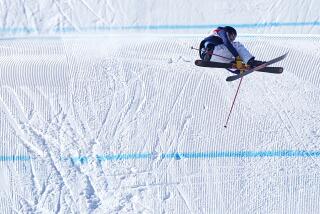Freestyle Skiing : ‘Hotdogs’ Shake Off Injuries So They Can Soar for Their ‘Sport’
- Share via
CALGARY, Canada — She was back on the slope where only the day before, a gust of wind had pulled her out of her double twisting triple backflip a quarter-twist short and sent her tumbling head over skis down the hill. She had suffered a mild concussion, and there were cuts on her chin and cheeks, but Maria Quintana was here Tuesday afternoon, assuring the crowd at Canada Olympic Park that she was OK.
Now Quintana was watching a fellow American freestyle aerial skier, Chris (the Hatchet) Haslock, competing despite suffering a concussion himself in a practice run four days earlier, careen down the hill after another crash landing.
For a few moments, Haslock lay motionless in the snow while first-aid attendants rushed to his side. Quintana, however, did not move.
“He’s fine,” Quintana said.
Haslock was still on his back when a voice boomed over the public-address system, over the din of the Talking Heads and the Cult and Katrina and the Waves, the sounds of music that accompany this demonstration sport.
“Chris, give us a wave of the hand,” the P.A. announcer implored.
Right on cue, Haslock weakly raised his right hand. The crowd cheered, and a couple of minutes later, Haslock was on his feet. There would be no more skiing for Haslock this day, but there was no doubt he would be back for more. As would Quintana.
That’s the nature of the sport, dismissed as “hotdogging” when it first burst into prominence in the ‘70s --and the skiers who seek that extra thrill that comes from acrobatic sky-writing.
“You need a kind of crazy, outgoing personality,” said Kris Feddersen, who washes windows in Steamboat Springs, Colo., when he’s not training or competing as a freestyle aerialist.
Tuesday, Feddersen finished fourth in the aerials, which was dominated by the “Quebec Air Force”--Canadians Jean Marc Rozon, who finished first, and Lloyd Langlois, who finished third.
“You have to be the kind of person who likes thrills, who likes to drive fast, and live recklessly,” said Feddersen, 25, who lists one of his ambitions is to appear on the cover of Rolling Stone magazine.
If the freestyle aerialist has a kindred spirit, Feddersen said, it is the California surfer. Although Park Smalley, the coach of the U.S. freestylers, is sensitive to the inference that his skiers are undisciplined, laid-back types.
“Take your ‘hotdogs’ and put mustard on them,” said Smalley, 34, a former pro freestyle skier who in his fifth year as U.S. coach. “These skiers are relatively intelligent people. It takes a tremendous ability to concentrate to be an aerialist. These people train as hard, year-round, as athletes in any other sport.”
While freestyle skiing--which, in addition to aerials, includes ballet and moguls (the performance of acrobatic maneuvers over bumps)--may have once been likened to a freak show, it now has major corporate sponsorship in the U.S. Subaru cars, Toblerone chocolates, and Pan Am airlines all contribute to his program, Smalley said.
Feddersen said he first met Smalley when he was 13.
“I saw it on TV during the ‘hotdog’ days, and read a lot about it in magazines,” Feddersen said. “I knew I had to flip on skis.”
Quintana, who will be 21 in July and plans to continue pre-med studies at Stanford this fall, was 5 when she started skiing, 8 when she first tackled moguls, and 15 when she entered the freestyle program. At 19, she won the aerials at the International Freestyle Skiing world championships.
“I never thought I’d be doing flips,” she said. “On my first snow jump, I landed in a heated swimming pool. I didn’t know what I was doing, but it was exciting, it was fun. There’s a big adrenaline rush. It’s so exciting, to be upside down, looking at your landing, then come in and land.
“It’s not like I was out trying to find the craziest thing I could do. There’s a lot of things I wouldn’t do. People look at the sport and say, ‘That’s crazy,’ but you have to look at it with an open mind.”
Smalley said that to succeed in freestyling, not only must you be able to concentrate, you have to stay healthy. And that’s no small task, even though Smalley said there hasn’t been a serious (as in life-threatening) injury since 1976. Smalley’s own career ended with a knee injury in 1976. Quintana had to wear a fiberglass cast here to protect the wrist she fractured while competing in a World Cup event in Breckenridge, Colo., before she came here.
And Feddersen missed all of the 1986 season after tearing up his knee.
“I lost a ski coming off a jump in France,” he said, “and my right leg sank into the snow up to my kneecap. It ripped all of my ligaments.”
Still, the freestylers insist that their sport is no more dangerous than gymnastics or diving. Some people are more easily convinced than others, however.
“My mom is definitely scared,” Quintana said, “but that’s understandable, since she really doesn’t understand the sport. She supports me, but she has told me that she’d still love me if I don’t do it.”
More to Read
Go beyond the scoreboard
Get the latest on L.A.'s teams in the daily Sports Report newsletter.
You may occasionally receive promotional content from the Los Angeles Times.






